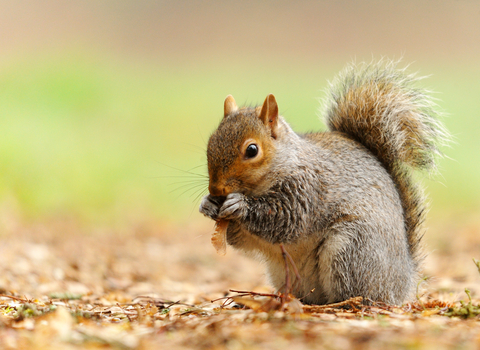
©Amy Lewis
Grey squirrel
Scientific name
Sciurus carolinensisWhen to see
January to DecemberSpecies information
Category
Statistics
Length: 24-28.5cmTail: 19.5-24cm
Weight: 400-650g
Average lifespan: 2-5 years
Habitats
About
One of our most familiar mammals, the grey squirrel can be found in woods, gardens and parks across town and country, and often proves to be very tame. It is a frequent visitor to gardens with bird tables and feeders. Grey squirrels feast on hazelnuts by cracking the shell in half. You may also find pine cones that have been nibbled, leaving what looks like an apple core behind. They will cache their food in autumn if it is abundant. Grey squirrels make a rough nest, called a 'drey' out of twigs, leaves and strips of bark in the fork of a branch, high up in the tree canopy. Females may have two litters of three to four young a year.How to identify
The grey squirrel has a silver-grey coat, with a brownish face and feet, and pale underside. It has a characteristically bushy tail. It is distinguished from the red squirrel by its larger size, grey fur, and smaller ears without tufts. However, grey squirrels can vary in colour, with some appearing slightly ginger.Distribution
Widespread in England, Wales and central Scotland.In our area
In Shropshire, grey squirrels can be seen almost everywhere. Since first appearing in the county in the 1950s, the numbers of greys have increased dramatically and they have now completely displaced the native red squirrel. Grey squirrels carry a disease that is deadly to red squirrels. Squirrel pox is a horrendous condition that causes infections under the skin, causing skin and fur to flake away and leaving open sores and wounds that leave the victim unable to feed or move around in search of water successfully. Infected red squirrels often suffer for two weeks or more before succumbing to the symptoms, In contrast, grey squirrels were exposed to the virus many generations ago and by the time greys were released in the UK last century, most of them had built an immunity to squirrel pox. Through interactions with red squirrels, the greys spread the plague throughout the English red squirrel population, with only small red populations on islands such as the Isle of Wight and Man, escaping the spread.
Grey squirrels are true survivors and are often much more successful at storing food and sniffing out food stores left by other mammals, including red squirrels and dormice. They also arrived in the UK at a time when there were few natural predators to hunt them. Like other introduced species, grey squirrels have had a dramatic impact on our native fauna
Did you know?
Grey squirrels are renowned for their agility, adept climbing and cunning - they can crack open bird feeders and run along tight-rope washing lines to get at their nutty prize.In Shropshire, grey squirrels can be seen almost everywhere. Since first appearing in the county in the 1950s, the numbers of greys have increased dramatically and they have now completely displaced the native red squirrel. Grey squirrels carry a disease that is deadly to red squirrels. Squirrel pox is a horrendous condition that causes infections under the skin, causing skin and fur to flake away and leaving open sores and wounds that leave the victim unable to feed or move around in search of water successfully. Infected red squirrels often suffer for two weeks or more before succumbing to the symptoms, In contrast, grey squirrels were exposed to the virus many generations ago and by the time greys were released in the UK last century, most of them had built an immunity to squirrel pox. Through interactions with red squirrels, the greys spread the plague throughout the English red squirrel population, with only small red populations on islands such as the Isle of Wight and Man, escaping the spread.
Grey squirrels are true survivors and are often much more successful at storing food and sniffing out food stores left by other mammals, including red squirrels and dormice. They also arrived in the UK at a time when there were few natural predators to hunt them. Like other introduced species, grey squirrels have had a dramatic impact on our native fauna
